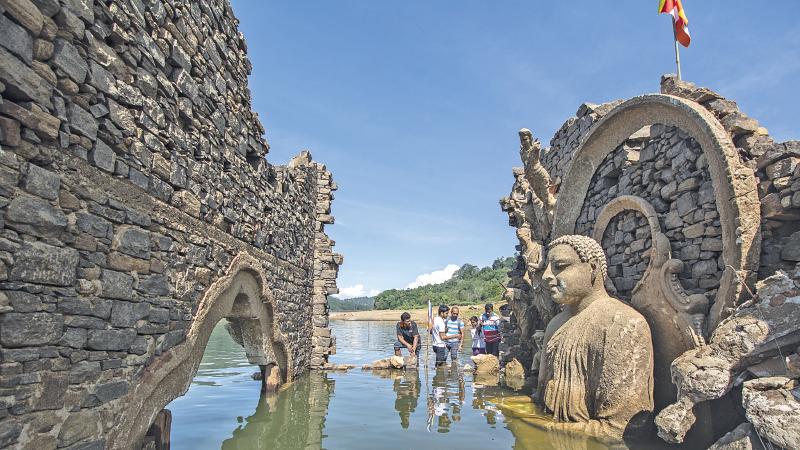

It is a surreal sight to behold. Visitors flocking to the reservoir bed of Kotmale to see the half-visible temple during the drought, wander through the crumbling, yet elegant temple with its antique architecture.
I clicked these enduring images of humanity displaying gratitude which are perfect examples of how life goes on with nostalgic memories of one’s past, during my photographic stint at the reservoir bed of Kotmale, recently.
Kotmale is an important historical place in the central highlands known as Malaya Rata on the ancient Sri Lanka map where Prince Gemunu, who later became King Dutugemunu makes his mark, fleeing from the Ruhun Rata to the Malaya Rata. Later on, this historically important region became the land of the Sinhala kings and peasants. The Sinhala villagers built the Kadadora Viharaya, in the Kadadora village near Dehedukadulla on the banks of the Kotmale Oya, which is a main tributary of the Mahaweli Ganga, and one of the historic sites in Kotmale in the early part of 1900. They would not have had an inkling even in their wildest dreams that the river would, about half a century later, engulf their places of worship. When the Kotmale dam, a major reservoir under the Mahaweli Development Program, was built across the Kadadora and Tispane hills in 1979, the people of the ancestral villages were relocated when the temple went under water. Since then, the temple structure plays the game of hide and seek – under water when it rains and out during the drought season – earning it the name ‘hiding temple.’
Moreover, more than 50 temples were inundated when the Kotmale reservoir was constructed damming Tispane and Kadadora hills and a massive chaitya known as the Mahaweli Maha Seya constructed on the summit of the Kadadora hill overlooking the Kotmale reservoir to symbolize the submerged religious monuments.
When it surfaces, visitors come in their hundreds, and offer flowers and get blessings. It has now become a popular backdrop for selfies. The villagers of the submerged village have not lost their ties with the temple. In the months of March and April, when the water level is low and the stone built crumbling temple is visible, they gather around gazing at the majestic remains of the decaying statue of the Buddha, harking back to a time when the temple called the faithful to prayer.

